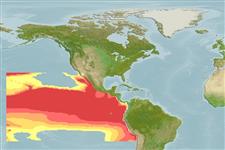Classification / Names
Nombres comunes | Sinónimos | Catalog of Fishes(Género, Especie) | ITIS | CoL | WoRMS | Cloffa
>
Scombriformes (Mackerels) >
Chiasmodontidae (Snaketooth fishes)
Etymology: Pseudoscopelus: Greek, pseudes = false + Greek, skopelos = a lantern fish (Ref. 45335). Lütken did not recognize the presence of photophores on the body, confusing them with pores, but referred to a genus of lanternfish (Scopelus now Myctophum) when he named the genus (Ref. 85782); lavenbergi: Named after Robert J. Lavenberg, for his contribution to the knowledge of the genus Pseudoscopelus..
Environment: milieu / climate zone / depth range / distribution range
Ecología
marino batipelágico; rango de profundidad 0 - 2100 m (Ref. 75982). Subtropical; 32°N - 23°S
Eastern Pacific: California, USA to Chile.
Tamaño / Peso / Age
Maturity: Lm ? range ? - ? cm
Max length : 18.1 cm SL macho / no sexado; (Ref. 75982)
Short description
Morfología | Morfometría
Espinas dorsales (total): 8; Radios blandos dorsales (total): 23-25; Vértebra: 37 - 39. Differs from other species of the genus by the following three unique characters: random trunk photophores in broad band of three or more rows; postventral-fin photophores short, not extending to anus, and reaching anteriorly to very close to pelvic-fin origin; absence of maxillary photophores and presence of anteropreopercular photophores (Ref. 75982).
Life cycle and mating behavior
Madurez | Reproducción | Puesta | Huevos | Fecundidad | Larva
Melo, M.R.S., H.J. Walker Jr. and C. Klepadlo, 2007. Two new species of Pseudoscopelus (Teleostei: Chiasmodontidae), with a new diagnosis for the genus. Zootaxa 1605:33-46. (Ref. 75982)
IUCN Red List Status (Ref. 130435)
Human uses
Más información
Nombres comunesSinónimosMetabolismoDespredadoresEcotoxicologíaReproducciónMadurezPuestaAgregación para la puestaFecundidadHuevosEgg development
Age/SizeCrecimientoLength-weightLength-lengthLength-frequenciesMorfometríaMorfologíaLarvaDinámica larvariaReclutamientoAbundanciaBRUVS
ReferenciasAcuiculturaPerfil de acuiculturaRazasGenéticaElectrophoresesheritabilidadEnfermedadesProcesamientoNutrientsMass conversion
ColaboradoresImágenesStamps, Coins Misc.SonidosCiguateraVelocidadTipo de nataciónSuperficie branquialOtolitosCerebrosVisión
Herramientas
Special reports
Download XML
Fuentes de Internet
Estimates based on models
Preferred temperature (Ref.
123201): 5.1 - 11.1, mean 7.8 °C (based on 32 cells).
Phylogenetic diversity index (Ref.
82804): PD
50 = 0.5000 [Uniqueness, from 0.5 = low to 2.0 = high].
Bayesian length-weight: a=0.00389 (0.00180 - 0.00842), b=3.12 (2.94 - 3.30), in cm total length, based on all LWR estimates for this body shape (Ref.
93245).
Nivel trófico (Ref.
69278): 3.7 ±0.2 se; based on size and trophs of closest relatives
Fishing Vulnerability (Ref.
59153): Low vulnerability (12 of 100).
